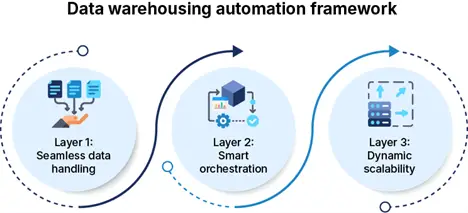Click here to get this post in PDF
For modern businesses, traditional methods of data storage are proving to be bumps in the smooth road of strategy, burdened with challenges such as limited scalability, escalating costs, slow access speeds, and the threat of data loss due to hardware failure. They struggle to keep pace with rapidly growing data volumes and require significant upfront investments in infrastructure and ongoing maintenance.
Since the advent of AI, we’ve looked to incorporate it into every system to solve its challenges. But can it revolutionize data warehousing as well?
There’s a widely repeated notion — AI-powered solutions are starting to mimic the human brain. By embedding this “brain” into data warehousing, we could unlock an innovative, smart solution. AI-backed data warehouses are digital banks that seamlessly integrate vast amounts of information, analyze patterns, and bring instantaneous decision-making to unprecedented levels. The cognitive engines of businesses are being transformed as we speak, while real-time analytics and predictive insights are getting more accessible.
“The first rule of any technology used in a business is that automation applied to an efficient operation will magnify the efficiency.” – Bill Gates
This sentiment highly resonates with the role data warehousing plays in 2025. Integration of AI in enterprise data warehousing brings multi-pronged advantages. Decision-making is getting faster, and operational overheads are being reduced. According to a Deloitte study, 25% of enterprises using generative AI are predicted to deploy AI agents by 2025. This figure is estimated to double by 2027 based on these trends.
This blog is a foray into the evolving world of data management to understand how AI and automation are revolutionizing data warehousing. We will touch upon points from intelligent data integration to automated governance and predictive analytics — key factors shaping the future of data warehousing.
The shift to AI-driven data warehousing
Data warehousing used to be a static and periodic activity rather than a real-time, dynamic and intelligent process. Infusion of AI and automation revolutionized data warehousing. This inclusion transformed this scheduled activity into an intelligent ecosystem. Here’s how these technologies are reshaping the landscape:
Seamless data integration
AI-powered data warehouses bring together diverse datasets from multiple sources, ensuring accurate integration and minimizing discrepancies.
Real-time analytics and insights
With advanced machine learning models and AI-powered analytics, these systems analyze patterns, detect anomalies, and deliver predictive insights faster than ever before, enabling organizations to make agile, data-driven decisions.
Automated data orchestration
With the elimination of manual error, the data ingestion, transformation, and governance processes were streamlined, reflecting more efficiency.
Dynamic adaptability
Changing market demands warrant continuous adaptation to stay afloat, and AI models drive meaningful change by constantly learning and responding to evolving dynamics.
Compliance and governance
AI-powered data warehousing streamlines compliance by automating regulatory checks, enforcing governance policies, and mitigating risks instantly.
Insider edge: Businesses aiming to harness these innovations can explore platforms like Agentic AI, which offers comprehensive solutions for predictive analytics, intelligent data integration, and automated governance. Such services help organizations unlock the full potential of their data ecosystems.
Automation: The backbone powering the future of data warehousing
Think of automation in data warehousing as a three-layer framework that drives efficiency across every level of operations:
Layer 1: Seamless data handling
Automated pipelines ingest and process vast amounts of structured and unstructured data from diverse sources. By standardizing formats and maintaining data quality, these systems eliminate human errors and ensure real-time availability for analysis.
Layer 2: Smart orchestration
Automation takes the lead in orchestrating workflows — from managing permissions to ensuring compliance and maintaining data lineage. Predefined rules and workflows simplify governance, reducing risks while ensuring transparency across the entire data lifecycle.
Layer 3: Dynamic scalability
As data volumes and queries fluctuate, automation adapts seamlessly, scaling systems without compromising speed or performance. This ensures businesses can manage surges or spikes in workloads with ease, maintaining operational continuity.
Why it matters: Automation doesn’t just support processes; it transforms them into agile, scalable, and error-free operations. By automating the backbone of data warehousing, businesses unlock the full potential of their data, focusing their efforts on what matters most: insights and decisions.
Smart data warehousing: Key pillars and business benefits
In shaping the future of data warehousing, four foundational pillars emerge as the bedrock for innovation and efficiency. Each pillar is intrinsically tied to an advantage that drives measurable outcomes for businesses:
Pillar 1: Data architecture
Advantage: Real-time data integration
A sound architecture enables real-time integration, enhancing agility and responsiveness to competition through data-driven decisions.
Pillar 2: Operational agility
Advantage: Scalability with savings
Operational agility allows businesses to scale resources as required while minimizing costs, ensuring both growth and efficiency.
Pillar 3: AI/ML integration
Advantage: Predictive insights
Integrating artificial intelligence and machine learning provides valuable predictive insights, empowering businesses to anticipate trends and mitigate risks.
Pillar 4: Data security and governance
Advantage: Risk mitigation and error-free operations
Robust data governance ensures accurate, consistent data, reducing errors and fostering smooth, secure operations.
How these pillars empower transformation: Together, these pillars elevate data warehouses into dynamic hubs of innovation, enabling organizations to adapt, predict, and excel in 2025 and beyond.
Navigating the roadblocks: Challenges and solutions
Perfection does not exist on its own in human engineered systems, but its closest version is achieved through countless iterations. Any new technology being adopted in its early stages comes with its own challenges and obstacles. As more and more businesses adapt AI and automation in their data warehouse solutions, new problems will emerge ranging anywhere from capital allocation, skill shortages, and problems pertaining to data security. Carefully planned strategies and their right execution can mitigate these barriers.
Here’s a breakdown of the key challenges and actionable solutions to overcome them:
| Challenge | Impact | Solution |
| High initial costs | Investment in infrastructure and AI tools can strain budgets. | Implement phased adoption and optimize resources effectively. |
| Skill gaps | Lack of expertise can slow integration and innovation. | Offer tailored training programs and upskill existing teams. |
| Data security concerns | Increased automation heightens the risk of breaches and compliance issues. | Use AI-driven monitoring tools and enforce strict compliance. |
Next-gen trends: Data warehousing in 2025 and beyond
Trends to keep an eye on
• Sustainability: A focus on eco-friendly data management and reduced carbon footprints.
• Robotics: Integration of robotics for data handling, improving accuracy and speed.
• AI advancements: Next-gen AI tools will push the boundaries of data processing, delivering real-time insights.
Why businesses can’t ignore these trends
AI-powered data warehouses are not just trends—they’re key to fending off competition and staying ahead in a fast-paced world.
Your next move
Act now to implement these solutions and ensure your enterprise is future-ready. The future of data warehousing starts today.
The road ahead: Disrupting digital data strategy for success
It bears repeating that AI and automation are revolutionizing data warehousing. Businesses are gaining new efficiencies in terms of actionable real-time insights, optimized decision-making, and streamlined operations. Organizations are set to unlock the true potential of their data ecosystems by embracing these technologies as early as possible. This prepares them for a future where data-driven decisions are pivotal. Leveraging professional data warehouse services ensures businesses have the expertise to navigate challenges, implement innovative solutions, and achieve their strategic goals with confidence.
Also read:
The Rise of SaaS with AI: Ahmed Abdullah’s Contribution to Operational Efficiency
Meet Chronicle: The ‘Cursor for Presentations’ with 100k+ Waitlisted Users Launches Public Beta
Image source: elements.envato.com


